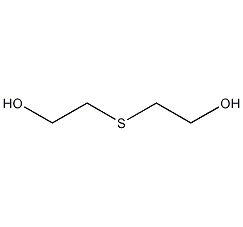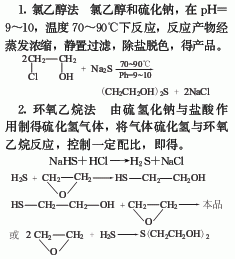
Structural formula
| Business number | 033N |
|---|---|
| Molecular formula | C4H10O2S |
| Molecular weight | 122.19 |
| label |
Bis(2-hydroxyethyl)sulfide, Thiodiglycol, Thiobis ethanol, 2,2′-Mercaptodiethanol (thiodiglycol), 2,2′-Thiodiethanol, 2,2′-thiobisethanol, Dihydroxyethyl sulfide, 2-(2-Hydroxy-ethylsulfanyl)-ethanol, Bis(2-hydroxyethyl) sulfide, Thiodiethylene glycol, Solvents for printing inks, antioxidants, straight chain compounds, Raw materials and intermediates used in ink |
Numbering system
CAS number:111-48-8
MDL number:MFCD00002910
EINECS number:203-874-3
RTECS number:KM2975000
BRN number:1236325
PubChem number:24850185
Physical property data
1. Properties: colorless or light yellow liquid with foul odor.
2. Density (g/mL, 0/4℃): 1.1973
3. Density (g/mL, 20/4℃): 1.1817
4. Density (g/mL, 25/4℃): 1.1793
5. Melting point (ºC): -10
6. Boiling point (ºC, normal pressure): 282
7. Boiling point (ºC, 2.0kPa): 165
8. Refractive index (20ºC): 1.52031
9. Refractive index (25ºC): 1.5143
10. Flash point (ºC): 160
11. Solubility: miscible with water and alcohol. Slightly soluble in ether, benzene and carbon tetrachloride.
Toxicological data
1. Irritation: Rabbit percutaneous open irritation test: 500mg mild irritation.
Rabbit transocular standard Drez dye eye test: 500mg moderately irritating.
2. Acute toxicity: rat oral LD50: 6610mg/kg; rat subcutaneous LD50: 4g/kg; Transdermal LD50: 20ml/kg;
Rabbit intravenous LD50: 3g/kg; Guinea pig oral LD50: 3960mg/kg
Ecological data
Slightly harmful to water bodies.
Molecular structure data
1. Molar refractive index: 31.64
2. Molar volume (cm3/mol): 103.5
3. Isotonic specific volume (90.2K ): 275.4
4. Surface tension (dyne/cm): 50.0
5. Polarizability (10-24cm3): 12.54
Compute chemical data
1. Reference value for hydrophobic parameter calculation (XlogP): None
2. Number of hydrogen bond donors: 2
3. Number of hydrogen bond acceptors: 3
4. Number of rotatable chemical bonds: 4
5. Number of tautomers: none
6. Topological molecule polar surface area 65.8
7. Number of heavy atoms: 7
8. Surface charge: 0
9. Complexity: 28.9
10. Number of isotope atoms: 0
11. Determine the number of atomic stereocenters: 0
12. Uncertain number of atomic stereocenters: 0
13. Determine the number of chemical bond stereocenters: 0
14. Number of uncertain chemical bond stereocenters: 0
15. Number of covalent bond units: 1
Properties and stability
1. Avoid contact with oxides. Can form adducts with calcium chloride.
2.Hydrogen sulfide gas is generated during the production process of this product, so measures should be taken according to the protection requirements for toxic hydrogen sulfide gas.
Storage method
1. Store sealed in a cool, dry place. Make sure the workspace has good ventilation. Keep away from sources of fire. Store away from oxidizing agents.
2. Packed in plastic barrels, 25kg per barrel. This product is flammable, so pay attention to fire prevention during storage and transportation. Keep away from fire and heat sources. Store in a cool, ventilated and dry place.
Synthesis method
Add chlorohydrin and sodium sulfide into the reaction kettle in sequence, and raise the temperature to 90~95°C while stirring. After the reaction is completed, the material is cooled and neutralized with sulfuric acid until the pH value becomes neutral. The thiodiethyl alcohol fraction was collected through filtration and vacuum distillation.

Purpose
1. Used as raw materials for mustard gas, dye additives, etc., and solvents for printing inks. Also used in antioxidants, printed and dyed fabrics and organic synthesis.
2.Used as a co-solvent for various cationic dyes and vat dyes, as well as a size adjuster, leveling agent, and moisture absorber for vat dye printing. agent.

 微信扫一扫打赏
微信扫一扫打赏

